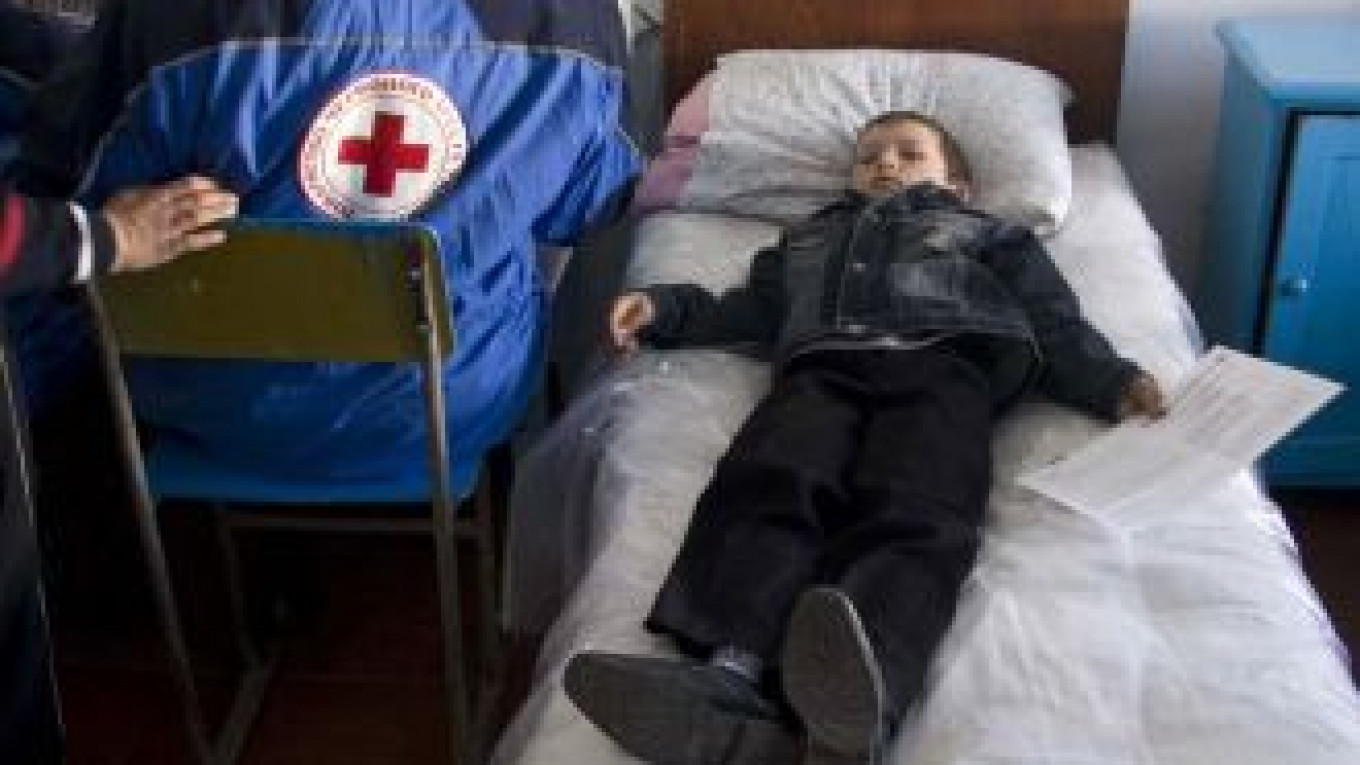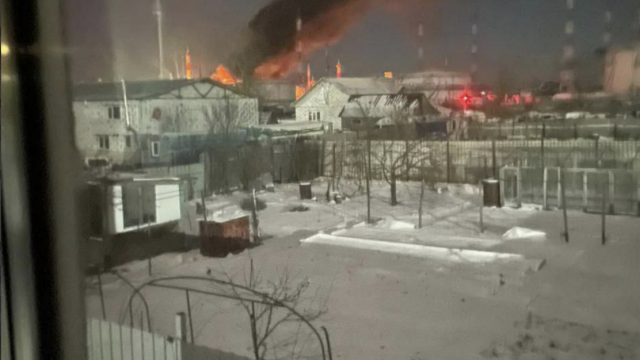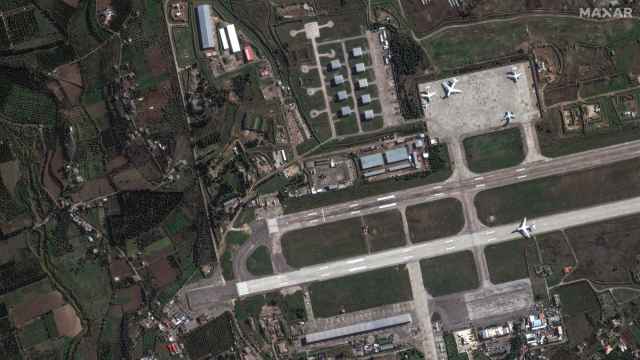Editor's note: This is the second of a three-part series about the Chernobyl disaster.
UKRAINKA, Ukraine — Lidiya Makarova spent most of her 69 years in a village within the contamination zone of the 1986 Chernobyl accident. But this month is the first time she decided to have her thyroid screened.
"I have never felt that I needed it," Makarova explained as she waited in a short line before a mobile lab of the Ukrainian Red Cross Society at her new home in Ukrainka, a village in the region outside Kiev.
"Maybe our bodies have adapted after the accident," she said with a proud smile, adding that she decided to get tested "for peace of mind."
Several minutes later, her smile faded and eyes widened with shock as medics told her there was a medium-sized lump in her neck that might be a thyroid gland cancer — a disease common to people, especially children and adolescents, exposed to radiation from the Chernobyl explosion.
Everyone was evacuated from the 30-kilometer-wide exclusion zone, but the radiation cloud covered vast swathes of Ukraine, Belarus and Russia, afflicting thousands of people like Makarova — and possibly millions more. Many people diagnosed with radioactive-linked illnesses in Ukraine, Belarus and Russia get insufficient medical help, or none at all.
What's more, thyroid gland cancer is the only direct consequence of the 1986 disaster recognized by the World Health Organization, which rejects a growing number of independent studies indicating that the aftereffects of protracted exposure to low-level radiation might be much more far-reaching.
Delivering Help
Makarova is one of 105,000 people who will be screened this year by the mobile lab as a part of the Red Cross' Chernobyl Humanitarian Assistance and Rehabilitation Program in contaminated areas. Many of those people have not been screened for thyroid gland cancer in recent years — if ever.
"We often go to areas where there are no other medical workers," said Lyudmila Khomenko, head of the five-member mobile team that conducted the testings in Ukrainka, some 150 kilometers south of the exclusion zone.
Khomenko's mobile team is one of two operating in Ukraine, where they revisit locations every two to three years. Five additional teams work in Belarus and Russia.
About 70 percent of people in areas near the exclusion zone turn out to have symptoms upon examination, with the figure decreasing to a still-dismal 50 percent in regions further away from Chernobyl, Khomenko said.
"Lots of people remain unscreened," she said, standing in the hall of the Ukrainka medical center preparing to examine a group of grade-schoolers. The center is warmed by a stove because there is no central heating.
Many rural residents are reluctant to undergo medical testing, either because they are busy with their lives or simply feel no need, Khomenko said.
"A person can feel that nothing's seriously wrong because [cancer] symptoms may be simple fatigue or a headache," said Khomenko, who joined the program in 1999.
Still, 20 to 30 people on average come for screening during a Red Cross visit in small localities, while in bigger settlements the number stands at 60 to 70 a day, she said.
A positive test result does not necessarily mean cancer but mandates further testing and, if not prevented, can lead to thyroid cancer, which is curable — with only two fatalities since 1990, when the Red Cross program was launched.
Both deaths from thyroid cancer were due to the illness being diagnosed too late. But many more deaths may go unregistered, as 50 percent of patients with suspected thyroid cancer "don't come for further examination," said Nikolai Nagorny, manager of the Red Cross program. He blamed "economic and geographical reasons" for the apathy.
"Given the current situation with Ukrainian health care, there are fewer and fewer affordable drugs," Khomenko said.
Moreover, diagnosing and treatment cannot be obtained onsite. Ukrainka resident Makarova said she would check in at a hospital in the city of Zhitomir, 170 kilometers away, for further testing.
Contaminated Zone
Unlike Japan's Fukushima nuclear station, another nuclear disaster site, Chernobyl's ill-fated reactor had no containment shell to stop radioactive dust from blowing into the atmosphere and being carried away by the wind. As a result, an area of more than 200,000 square kilometers was contaminated, 70 percent of it in Ukraine, Russia and Belarus.
Only the residents of the 10-kilometer zone surrounding the reactor were evacuated immediately after the blast on April 26, 1986. The exclusion zone was extended to 30 kilometers in the following days, but people outside the area continued with their everyday lives after the disaster, many not even aware of the contaminated air they were breathing.
The number of people living in areas where radiation is above normal stood at some 5 million across the three countries in 2006, the latest year for which World Health Organization figures are available. In the decade preceding the organization's report, radiation levels in those areas were four to eight times higher than the norm, although the levels were still classified as acceptable.
In Ukrainka, which now numbers some 800 residents, the population was only informed about the 1986 accident after the May Day and the Victory Day celebrations were over.
"We were not evacuated, and no one left on their own," Makarova recalled. Many residents were involved in the Chernobyl cleanup, and most have since died or suffer serious health problems, she said.
The locals were not even told to avoid mushrooms and berries from nearby forests and have kept them as part of their diet during the 25 years since the blast, said Makarova, who, admittedly, looks younger than her age, with pink cheeks and merry eyes framed by a colorful headscarf.
But a recent study by Greenpeace showed that milk, berries, potatoes and root vegetables in the nearby regions of Zhitomir and Rivne contained dangerously high amounts of radioactive elements.
Hidden Problems
The Red Cross program focuses mainly on thyroid screening and psychological assistance, which are globally and officially recognized effects of the Chernobyl disaster. But independent scientists say there might be more to cure.
"Today thyroid cancer is the only officially confirmed disease caused by [Chernobyl] radiation," Nagorny of the Red Cross said in an explanation of the screening program's goals.
Nearly 5,000 cases of thyroid cancer have been diagnosed among children aged under 18 at the time of the meltdown, according to WHO figures. The trend is still on the rise, and the Red Cross expects no reversal in the foreseeable future.
The global health body does not officially recognize the link between other forms of cancer and Chernobyl radiation. The organization said in 2006, for example, that abundant leukemia cases diagnosed in the wake of the meltdown were limited to liquidators who worked in the vicinity of the reactor, not residents of contaminated areas.
Calculating health effects is further complicated by indirect consequences, mainly psychological problems. "In contaminated areas, people are exposed to 'radiation-phobia,' which results in higher rates of drug use, smoking and alcohol consumption," Nagorny said.
Independent studies conducted since 1986 in Russia, Ukraine, Belarus and other countries show that the consequences of exposure to low-level radiation are much more alarming than the global community is willing to accept, said Alexander Glushchenko, a nuclear physicist and author of three books about Chernobyl.
"Today, 25 years after Chernobyl, numerous studies in different countries show that the frequency of congenital malformations in children of parents exposed to radiation increased five to seven times," Glushchenko said in an interview in Moscow.
But the WHO linked a "modest but steady increase in reported congenital malformations" to "improved [statistical] reporting," not higher radiation levels.
Glushchenko, a co-author of a Russian study on the subject, said that even small exposure to radiation can result in genome instability for several generations, leading to oncological diseases, primarily among children of those exposed.
"The fiendish thing about catastrophes like Chernobyl is that their effect is strengthening, not weakening, as the years go by," he said.
A Message from The Moscow Times:
Dear readers,
We are facing unprecedented challenges. Russia's Prosecutor General's Office has designated The Moscow Times as an "undesirable" organization, criminalizing our work and putting our staff at risk of prosecution. This follows our earlier unjust labeling as a "foreign agent."
These actions are direct attempts to silence independent journalism in Russia. The authorities claim our work "discredits the decisions of the Russian leadership." We see things differently: we strive to provide accurate, unbiased reporting on Russia.
We, the journalists of The Moscow Times, refuse to be silenced. But to continue our work, we need your help.
Your support, no matter how small, makes a world of difference. If you can, please support us monthly starting from just $2. It's quick to set up, and every contribution makes a significant impact.
By supporting The Moscow Times, you're defending open, independent journalism in the face of repression. Thank you for standing with us.
Remind me later.






